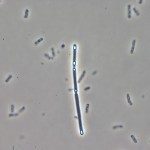Link to Pubmed [PMID] – 15292242
J. Biol. Chem. 2004 Oct;279(41):42560-5
D-Tyr-tRNATyr deacylase cleaves the ester bond between a tRNA molecule and a D-amino acid. In Escherichia coli, inactivation of the gene (dtd) encoding this deacylase increases the toxicity of several D-amino acids including D-tyrosine, D-tryptophan, and D-aspartic acid. Here, we demonstrate that, in a Deltadtd cell grown in the presence of 2.4 mm D-tyrosine, approximately 40% of the total tRNATyr pool is converted into D-Tyr-tRNATyr. No D-Tyr-tRNATyr is observed in dtd+ cells. In addition, we observe that overproduction of tRNATyr, tRNATrp, or tRNAAsp protects a Deltadtd mutant strain against the toxic effect of D-tyrosine, D-tryptophan, or D-aspartic acid, respectively. In the case of D-tyrosine, we show that the protection is accounted for by an increase in the concentration of L-Tyr-tRNATyr proportional to that of overproduced tRNATyr. Altogether, these results indicate that, by accumulating in vivo, high amounts of D-Tyr-tRNATyr cause a starvation for L-Tyr-tRNATyr. The deacylase prevents the starvation by hydrolyzing D-Tyr-tRNATyr. Overproduction of tRNATyr also relieves the starvation by increasing the amount of cellular L-Tyr-tRNATyr available for translation.
